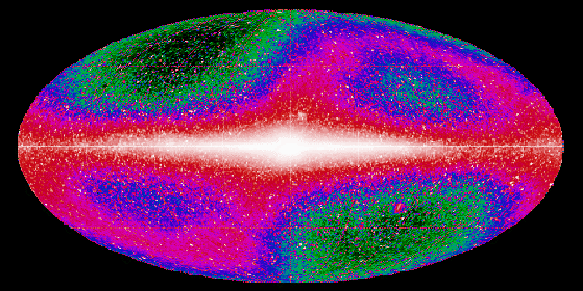Astronomy Picture of the Day
Discover the cosmos!
Each day a different image or photograph of our fascinating universe is
featured, along with a brief explanation written by a professional
astronomer.
September 18, 1996

Stars in the Infrared Sky
Credit:
The COBE Project,
NASA
Explanation:
What if you could see
infrared light?
Because this light is less
absorbed by dust
than visible light, you could
peer into the center of our Milky Way Galaxy. The stars there are
normally hidden from direct view by
the interstellar dust clouds which
line the Galactic plane.
Above is a false color image of the entire sky made by
the DIRBE instrument onboard
NASA's COBE Satellite using
infrared light with a wavelength of 3.5 microns
- about 7 times longer than the wavelength of visible light.
The galactic plane runs horizontally along the middle of the image.
At this wavelength, the
cool stars in our galaxy shine brightly and can be seen to define the
plane of the Milky Way and the central bulge.
Interplanetary dust,
which tends to lie along the plane of our
own solar system, scatters sunlight and emits radiation at these
wavelengths too.
The faint glow it produces results in the
"S" shape apparent in this infrared all-sky view.
Tomorrow's picture: The Moon and All the Crashes
| Archive
| Index
| Search
| Glossary
| Education
| About APOD |
Authors & editors:
Robert Nemiroff
(MTU) &
Jerry
Bonnell (USRA).
NASA Technical Rep.:
Sherri
Calvo.
Specific rights apply.
A service of:
LHEA
at
NASA/
GSFC
